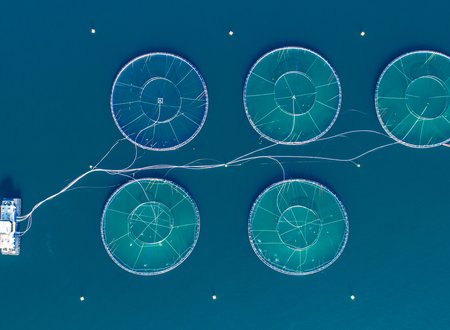Progress in the development of DNA vaccine against sea lice
The new findings could lead to a more sustainable and animal-friendly way to combat sea lice, and are a step towards a future vaccine.
Mexico launches global center for applied aquaculture innovation
Once fully constructed, the Center for Applied Aquaculture Innovation will offer state-of-the-art facilities including laboratories, hatchery, technology, and open-ocean projects.
Rabobank: Aquaculture industry navigates trade volatility with strong supply-side dynamics
According to a recent RaboResearch report, affordability and shifting trade dynamics are reshaping global seafood markets in 2025.
ASC to strengthen Ghana’s farmed seafood sector
ASC partnered with the Chamber of Aquaculture Ghana to transform farmed fish production towards sustainability, traceability, and global market alignment.
Cargill’s aquafeed operations in Scotland achieve ASC certification
With this achievement, all of Cargill’s feed operations supplying EWOS feed for salmonids are certified according to the ASC Feed Standard.
Aquaculture Award 2025 winners announced
The winners of this year’s Aquaculture Awards were announced at a celebratory dinner in Inverness attended by leading figures from across the sector.
Broodstock Capital invests in Norwegian hatchery producer
Broodstock Capital has acquired a major stake in Neptun Salmo, a Norwegian hatchery producer located in Nord-Trøndelag.
Skretting highlights social license, emission cuts and new sustainability vision in 2024 report
Skretting’s 2024 Impact Report highlights significant progress in sustainability, with CEO Bastiaan van Tilburg emphasizing the importance of transparency, collaboration, and the company’s new ACT value proposition to drive industry-wide change.
Therese Log Bergjord joins Aquaticode as strategic advisor
AI phenotyping company, Aquaticode, the AI phenotyping company, appointed Therese Log Bergjord as strategic advisor.
Nofima names new head of Fish Health Department
Kjetil Fyrand leaves Pharmaq to join Nofima and now leads the Fish Health Department.
INVE Aquaculture opens warehouse in Ecuador
The new facility, located in Santa Elena, improves logistics and reinforces its role as a reliable partner for hatcheries and producers.

LACQUA 2025 unveils program details
Aquaculture Award 2025 winners announced
WA25 Uganda conference program revealed
Dean Akiyama to receive Lifetime Achievement Award at Shrimp Summit

Investments in aquaculture could create more than 20 million jobs by 2050
Rabobank: Aquaculture industry navigates trade volatility with strong supply-side dynamics
Skretting highlights social license, emission cuts and new sustainability vision in 2024 report
Salmon short operculum linked to initial feeding and operational routines
Innovations in Hatchery Feeds
Aquaculture hatcheries traditionally rely on rotifer and Artemia as live feeds for the early larval stages. But technology is evolving and has allowed the industrial production of other live feed species and smaller dry feeds.
Hatchery Feed & Management hosted this webinar to discuss some of these recent innovations, with two of the recent disruptors in live feeds, CFEED and Planktonic, and inert feeds with BioMar.
Sponsored by CFEED and Planktonic.
Moderator: George Koumoundouros, Professor of Marine Biology, University of Crete
Vitapro launches new diet for shrimp broodstock
Nicovita introduces innovation to enhance the early stage of shrimp farming
INICIO N is built on four key pillars: high-quality larvae, an advanced initial feed portfolio, specialized technical advisory services, and precision-feeding technology.
Japanese company unveils land-based aquaculture system
The systems has the potential to efficiently farm large amounts of fish even for those with no aquaculture experience.
Skretting, Zooca introduce copepod feed for marine juveniles
Fish and shrimp hatcheries now have access to fresh, canned Calanus finmarchicus.
New IP camera purpose-built for AI applications in aquaculture
ReelData released a camera developed from the ground up for AI applications in aquaculture.

